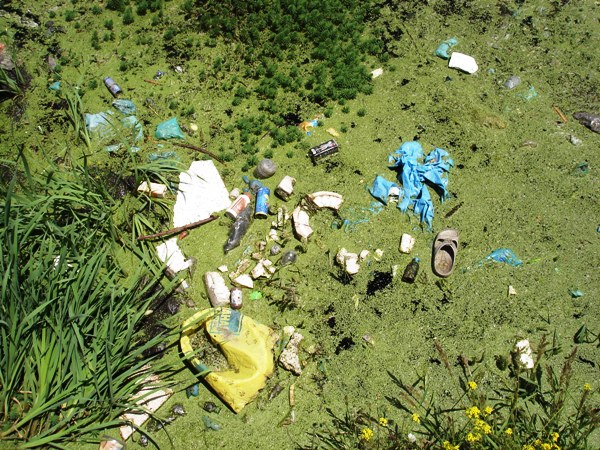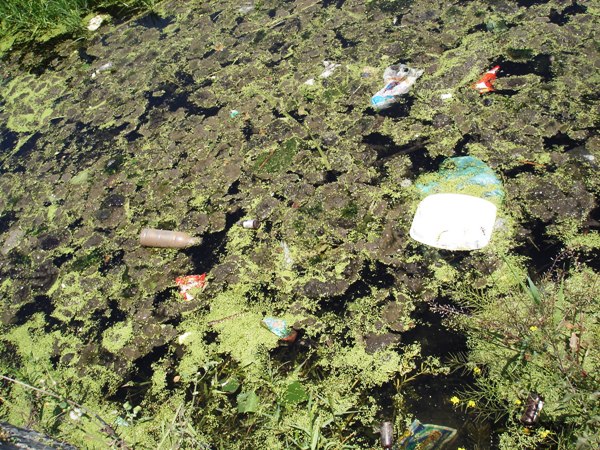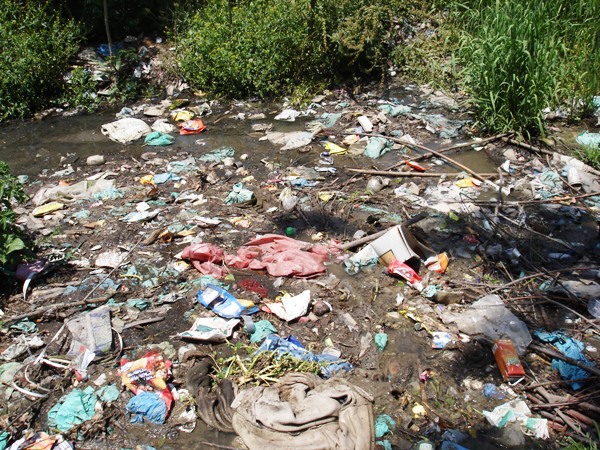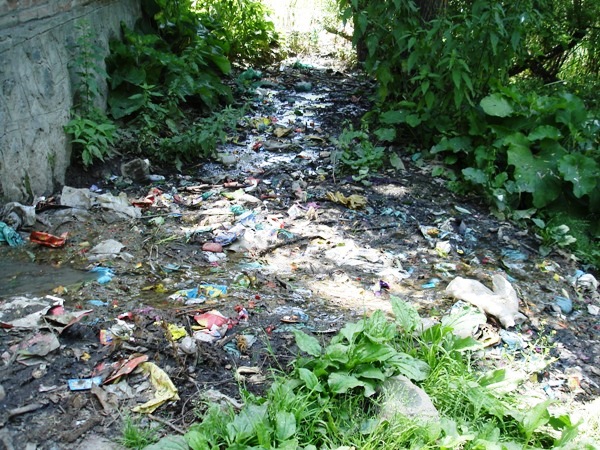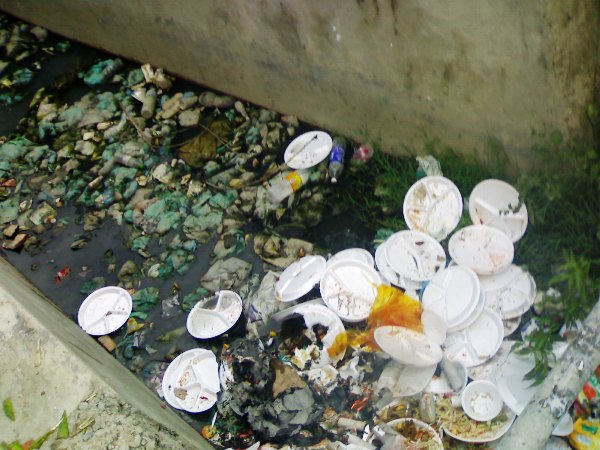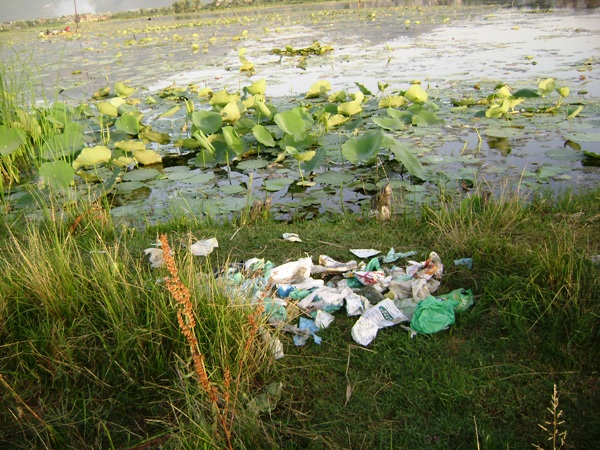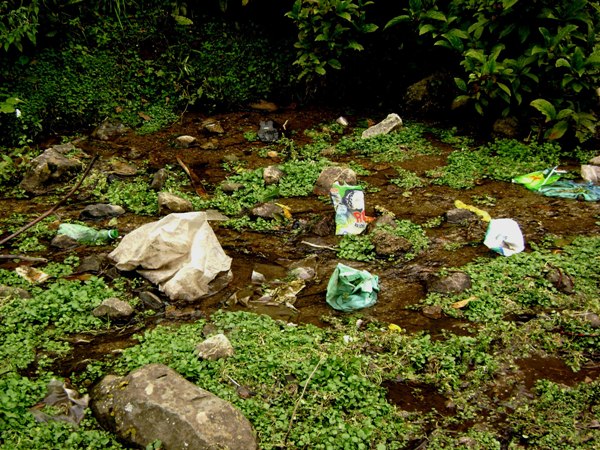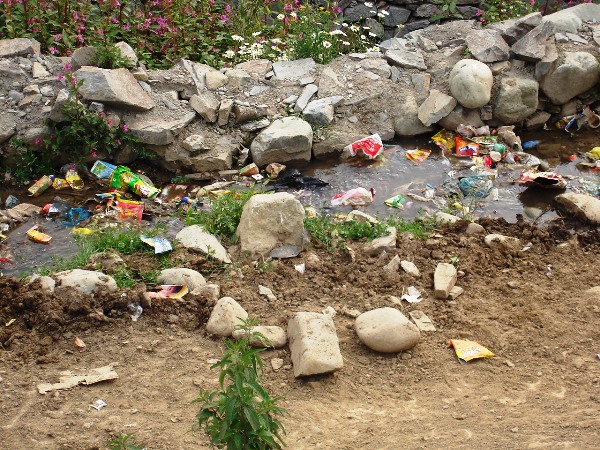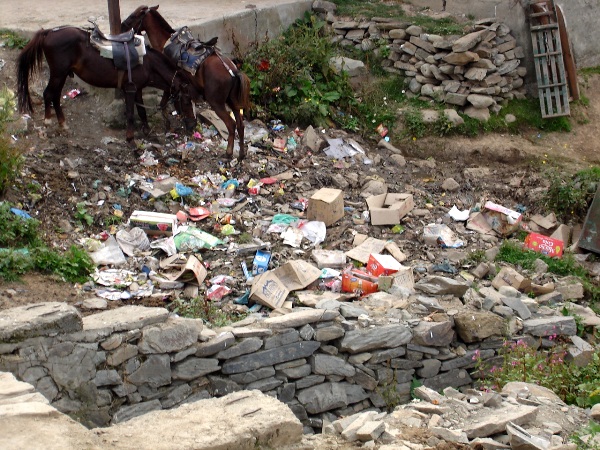Sunday, December 6, 2009
Telangana in limelight
Nine years after K Chandrasekhara Rao formed the Telangana Rashtra Samithi (TRS) with the objective of achieving a separate state of Telangana, the movement appears to have taken a decisive directional change, away from politicos to encompass a whole lot of other sections, mainly students and teachers. Over the past few days, three students committed suicide while a constable shot himself dead, hoping their deaths would end the perceived discrimination against the people of Telangana.
There are two ways in which one could look at the demand — either through the prism of TRS and what Rao and his men have done or not done since 2001 or independent of this. Let us look at both.
While none can take away the credit of bringing the issue to the limelight not only in the state but also at the national level from Rao, his fundamental mistake lay in complete reliance on political management to achieve the goal.
Within three years after forming the TRS, he was on Cloud Nine, sharing power with the Congress both in the state and at the Centre, having forged an alliance with it in the 2004 elections. Intoxicated by power, it took him two years to realise his folly and break out of the alliance as he came under pressure for ignoring the purpose for which he formed the TRS.
One fine morning in 2008, on the auspicious occasion of Dasara, Chandrababu Naidu of Telugu Desam Party, till then a strong votary of a united Andhra, declared support for a Telangana State. As a natural consequence, the TDP and the TRS came together during the 2009 polls which was rightly seen as opportunistic by the people. As the alliance bombed, both parted ways as quickly as they came together but with more rancour, and the TDP has since been silent on the demand.
As social scientist N Venugopal pointed out in the only English book brought out recently on Telangana, the TRS has never attempted to build a mass movement on issues concerning the region, whether it be projects taken up to benefit other regions by diverting water which should have been earmarked for Telangana or repatriation of non-local government employees in accordance with a formula laid down several years ago.
As someone who believes in himself, Rao has also utterly failed in building the party through village, mandal and district committees. Like most politicians, he too preferred his kin to sincere workers while allotting party tickets.
One might, therefore, wonder how the TRS has survived for nine years despite all the negative steps taken by Rao and why people moved in such large numbers when he wanted to launch a fast-unto-death a few days ago. The answer lies in what several political leaders, including Congress chief Sonia Gandhi have said time and again: “We are conscious of people’s craving for a separate state.” For one to understand this craving, one has to look at it through the other prism — independent of TRS — and from a historical, social and economic perspective which could be repetitive for those in the know of things but all the same important to be mentioned here.
Most parts of Telangana were under the control of the Nizam as part of the Hyderabad state even after India achieved independence, and people faced the tyranny of Razakars for years. Then followed the integration of Hyderabad into the Indian Union and the constitution of the States’ Reorganisation Commission under the chairmanship of Justice Syed Fazl Ali. People of Telangana never wanted to be a part of Andhra State, and this is precisely what was recommended by Fazl Ali: that Telugu-speaking districts of the erstwhile Nizam dominion be carved out to form a Hyderabad state independent of the rest of the Andhra state.
That did not happen and a unified Telugu state came into being with what was called a gentlemen’s agreement to protect the interests of Telangana. Every bit of it relating to financial resources, water, jobs etc., was violated leading to a violent agitation for a separate state in the late ’60s in which more than 350 students and youth died. The party which had spearheaded the movement then won handsomely in parliamentary elections but ultimately merged with the Congress and the leaders who championed the cause went on to hold high positions including chief ministership.
Over the years, successive governments, including those headed by leaders from the region, did little to assuage the sense of alienation or deprivation among the people. Inappropriate it might be but I should mention here a brief conversation I had with the late chief minister Y S Rajasekhara Reddy during the April-May elections this year. He made it clear then that as long as he was at the helm, there was no question of yielding to the demand for a separate Telangana state. In fact, he did everything possible to weaken the TRS and the lapses of Rao only made YSR’s task easier. The TRS was split by “weaning” away quite a few legislators, and its candidates were bought over.
But that was like applying balm to a disease that requires a surgery. Two months after YSR’s death, the issue has come to haunt the powers-that-be once again. Critics of Chandrasekhara Rao described his indefinite fast as yet another “drama” enacted in connivance with the establishment to shore up his plummeting image. Whether Rao himself wanted it or not, his fast has attracted wider sections of people, till now inactive, to the movement. They have declared that they would carry it forward, irrespective of Chandrasekhara Rao.
The least the government should do is open a dialogue with the interested groups, something that the Pranab Mukherjee committee set up way back in 2004, promised but never did. The last and the right course always exists: hold a referendum and seal the issue once and for all. If and when a Telangana state is formed, the people won’t forget the contribution of police officers who ordered caning on the students. Because, it is that image of the student being brutally caned which has spurred the current movement, something KCR has not managed to achieve in nine years.
vasu@expressbuzz.com
About the author: G S Vasu is Resident Editor, The New Indian Express (Andhra Pradesh) and is based in Hyderabad
Saturday, October 10, 2009
AP flood situation still fierce
 Andhra Pradesh geared up for more floods as the swollen Krishna river on Monday inundated parts of Vijayawada city and threatened to swamp 200 villages in Krishna and Guntur districts, while the overall situation continued to be grim in the rest of the state.
Andhra Pradesh geared up for more floods as the swollen Krishna river on Monday inundated parts of Vijayawada city and threatened to swamp 200 villages in Krishna and Guntur districts, while the overall situation continued to be grim in the rest of the state. The authorities are constantly monitoring the level at the Prakasam barrage across the Krishna river and they said if Monday night passed without much damage to the 200 villages downstream in the two districts the threat would be averted. Officials are describing it as the worst floods in the Krishna river in 100 years.
The focus of the flood threat has now shifted to the coastal areas. Kurnool and Mahboobnagar districts, which bore the brunt of the flood fury during the last four days, are struggling to return to normalcy. Though the officials have put the death toll at 49, it could go up as dozens of people are still reported missing.
The inflows in the Prakasam barrage have crossed a record million cusecs, inundating parts of Vijayawada, one of the state’s biggest cities with 1.2 million people, located on the banks of the river. Dozens of villages downstream have submerged while thousands of people are being evacuated. More than 200,000 people have been evacuated in Krishna and Guntur districts.
The weakening embankments at a few points along the river have raised the spectre of inundation of vast areas and authorities have mobilised 300,000 sand bags to strengthen the embankments. The water level at the barrage, the last irrigation project across the Krishna river before it joins the Bay of Bengal, stands at 21.5 feet. Though authorities said there was no threat to the barrage, the weakening embankments at a few points was worrying. The barrage has never faced such massive inflows in its history. “There is three to four feet water in some areas in Vijayawada city and this may go up to six to seven feet later. We have already moved out of the area near the river,” Suresh Kumar, a resident said.
Krishna District Collector Piyush Kumar said the army, navy and the NDRF men were ready with 100 boats and six helicopters to rescue people in the district. Vehicular traffic on the Hyderabad-Vijayawada highway came to a standstill as the highway was under water at several points. However, receding water levels at the Srisailam dam and in the tributaries of the Krishna have provided some respite to Kurnool and Mahbubnagar, where 1.1 million people have been affected. People are returning homes in Kurnool town.
Pathetic scenes were witnessed in the affected areas as men and women were trying to salvage whatever they could from the slush in their damaged houses. Debris, garbage and carcasses of cattle washed away by floods were seen scattered all over. Sanitation workers were having a tough time to take up cleaning work.
Ministers and officials who visited the affected areas had to face the ire of the people who protested the tardy relief work.
According to official figures, the floods have so far claimed 49 lives in five districts. Kurnool district accounted for 26 deaths while 17 people died in Mahbubnagar. The remaining deaths were reported from the Krishna district (three), Nalgonda (two) and Guntur (one).
About 500 villages were inundated by the floods that impacted over 1.8 million people in five districts. Over 400,000 people have been rendered homeless.
The State has doubled the compensation to Rs 200,000 even as it put the loss at Rs 12,225 crore and sought Rs 6,000 crore aid from the Centre
Saturday, August 15, 2009
Happy Independenceday to all
 "Long years ago we made a tryst with destiny, and now the time comes when we will redeem our pledge, not wholly or in full measure, but very substantially. At the stroke of the midnight hour, when the world sleeps, India will awake to life and freedom. A moment comes, which comes but rarely in history, when we step out from the old to the new, when an age ends and when the soul of a nation, long suppressed, finds utterance.... We end today a period of ill fortune, and India discovers herself again."
"Long years ago we made a tryst with destiny, and now the time comes when we will redeem our pledge, not wholly or in full measure, but very substantially. At the stroke of the midnight hour, when the world sleeps, India will awake to life and freedom. A moment comes, which comes but rarely in history, when we step out from the old to the new, when an age ends and when the soul of a nation, long suppressed, finds utterance.... We end today a period of ill fortune, and India discovers herself again."Sunday, July 26, 2009
India launches its first nuclear-powered submarine
The submarine, Arihant, the first of two similar submarines to be built indigenously with technical help from Russia, will undergo sea trials before its formal induction in 2015, defence officials said.
 Indian Air Force advanced light helicopters "Sarang" perform as India's national flag flutters during the inauguration ceremony of the "Aero India 2009" at Yelahanka air force station near Bangalore February 11, 2009. India launched on Sunday its first nuclear-powered submarine capable of firing ballistic missiles.
Indian Air Force advanced light helicopters "Sarang" perform as India's national flag flutters during the inauguration ceremony of the "Aero India 2009" at Yelahanka air force station near Bangalore February 11, 2009. India launched on Sunday its first nuclear-powered submarine capable of firing ballistic missiles. The project is part of a $2.9 billion plan to build five submarines, delayed for years due to technical problems, officials said.

The country already has fighter aircraft and missiles capable of carrying nuclear warheads.
Experts say India is modernising its armed forces and is focusing on improving its naval fleet with new ships and submarines to counter the strategic interest of China in the region.
China is India's biggest trade partner in Asia. But India, already wary of China's growing military might, fears its giant rival wants to strategically encircle India as Beijing continues to supply weapons to India's neighbours, Pakistan and Sri Lanka.
Last year's Mumbai attacks in which 10 gunmen arrived by the sea to kill 166 people also exposed glaring loopholes in its sea security.
"The sea is increasingly becoming relevant in the context of India's security interests and we must re-adjust our military preparedness to this changing environment," Prime Minister Manmohan Singh, said after launching the submarine for trials.
"We do not have any aggressive designs nor do we seek to threaten anyone. We seek an external environment ... conducive to our peaceful development and the protection of our value systems," Singh said at the southern port city of Vishakhapatnam.
India has 16 diesel-electric submarines of Russian and German origin, which are all 25-40 years old, defence officials said.
The 5,500 tonne nuclear-powered Arihant, when inducted, will be capable of carrying 100 sailors and a wide range of torpedoes and ballistic missiles, officials added.
Sunday, July 12, 2009
Save Life, Save Earth: ACT NOW AGAINST POLLUTION
According to the website www.chem.prenhall.com, the population growth and environment are intertwined. The increase in population leads to land clearing and habitat loss for other species, increased energy use with harmful industrial emissions, deterioration of water supply and other problems. As our resources dwindle, our mountains of garbage grow! And so was the emission of methane in the atmosphere. Truly, it is noted that methane (NH4) is a greenhouse gas- a factor contributing to the global warming problem.
There are many people in this world. And as we multiply, we consume more resources without even renewing an ounce of them, and worse, throwing our rubbish not into the trash can, but into the ground. I can relate to you some ecological problems and facts about them. You should read this between the lines, be the one to act first so everyone will follow, perform drastic measures in saving humanity’s haven- MOTHER EARTH.
Ø POLLUTION
Pollution is really part of our life. And the natural balance of Earth is now gone because of these. In some areas, the air is so bad that people become sick from breathing it, and some even die because of it.
Even before there were people, there was already air pollution. Volcanic eruptions and wildfires became events that continuously add pollutants to the atmosphere. The only main difference between air pollution problems today and in the past is that it is now difficult to get away from them.
In recent news, there is a now-dying (or totally died) river in Bulacan that belongs to the list of the World’s Top Fifty Dirtiest Rivers. It’s bad, but just up for now, we should do something to regain the life of this river and all of our water resources. Bring back the dead ones and regain marine life. We and the future generations greatly needed clean water.
We cannot totally eradicate pollution, because it is already stated in the 2nd law of thermodynamics-no process can be 100% efficient. Anyway, we can further minimize its cases by due cooperative efforts and measures.
1. Do not smoke. Its effects are generally obvious.
2. Do not burn wood, leaves and plastics. It can minimize our wastes but it can also destruct ecological balance and can also lead to asthma attacks and long-term effects in the lungs. Try segregating wastes.
So what are we waiting for? There is a small solution waiting to be administered against this problem. A small solution yet implies a big change among us.
Don't waste time. There is still time for this change. Not tomorrow but now.
Types of Pollutions
Pollution is the introduction of substances or energy into the environment, resulting in deleterious effects of such a nature as to endanger human health, harm living resources and ecosystems, and impair or interfere with amenities and other legitimate uses of the environment.[1] The major forms of pollution include:
* Air pollution, the release of chemicals and particulates into the atmosphere. Common examples include carbon monoxide, sulfur dioxide, chlorofluorocarbons (CFCs), and nitrogen oxides produced by industry and motor vehicles. Photochemical ozone and smog are created as nitrogen oxides and hydrocarbons react to sunlight.
* Water pollution via surface runoff and leaching to groundwater.
* Soil contamination occurs when chemicals are released by spill or underground storage tank leakage. Among the most significant soil contaminants are hydrocarbons, heavy metals, MTBE[2], herbicides, pesticides and chlorinated hydrocarbons.
* Radioactive contamination, added in the wake of 20th-century discoveries in atomic physics. (See alpha emitters and actinides in the environment.)
* Noise pollution, which encompasses roadway noise, aircraft noise, industrial noise as well as high-intensity sonar.
* Light pollution, includes light trespass, over-illumination and astronomical interference.
* Visual pollution, which can refer to the presence of overhead power lines, motorway billboards, scarred landforms (as from strip mining), open storage of trash or municipal solid waste.
* Thermal Pollution, is a temperature change in natural water bodies caused by human influence.
Sources and causes
pollution Motor vehicle emissions are one of the leading causes of air pollution.[3][4][5] China, United States, Russia, Mexico, and Japan are the world leaders in air pollution emissions; however, Canada is the number two country, ranked per capita. Principal stationary pollution sources include chemical plants, coal-fired power plants, oil refineries,[6] petrochemical plants, nuclear waste disposal activity, incinerators, large livestock farms (dairy cows, pigs, poultry, etc.), PVC factories, metals production factories, plastics factories, and other heavy industry. Some of the more common soil contaminants are chlorinated hydrocarbons (CFH), heavy metals (such as chromium, cadmium--found in rechargeable batteries, and lead--found in lead paint, aviation fuel and still in some countries, gasoline), MTBE, zinc, arsenic and benzene. Ordinary municipal landfills are the source of many chemical substances entering the soil environment (and often groundwater), emanating from the wide variety of refuse accepted, especially substances illegally discarded there, or from pre-1970 landfills that may have been subject to little control in the U.S. or EU. Pollution can also be the consequence of a natural disaster. For example, hurricanes often involve water contamination from sewage, and petrochemical spills from ruptured boats or automobiles. Larger scale and environmental damage is not uncommon when coastal oil rigs or refineries are involved. Some sources of pollution, such as nuclear power plants or oil tankers, can produce widespread and potentially hazardous releases when accidents occur. In the case of noise pollution the dominant source class is the motor vehicle, producing about ninety percent of all unwanted noise worldwide.
Effects on human health
Adverse air quality can kill many organisms including humans. Ozone pollution can cause respiratory disease, cardiovascular disease, throat inflammation, chest pain, and congestion. Water pollution causes approximately 14,000 deaths per day, mostly due to contamination of drinking water by untreated sewage in developing countries. Oil spills can cause skin irritations and rashes. Noise pollution induces hearing loss, high blood pressure, stress, and sleep disturbance.
Effect on ecosystems
* Sulfur dioxide and oxides of nitrogen can cause acid rain which reduces the pH value of soil.
* Soil can become infertile and unsuitable for plants. This will affect other organisms in the food web.
* Smog and haze can reduce the amount of sunlight received by plants to carry out photosynthesis.
* Invasive species can out compete native species and reduce biodiversity. Invasive plants can contribute debris and biomolecules (allelopathy) that can alter soil and chemical compositions of an environment, often reducing native species competitiveness.
Regulation and monitoring
To protect the environment from the adverse effects of pollution, many nations worldwide have enacted legislation to regulate various types of pollution as well as to mitigate the adverse effects of pollution.
Historical and projected CO2 emissions by country. Source: Energy Information Administration.
This information was brought to you by www.wikipedia.com
Thursday, July 9, 2009
Michael Jackson’s final resting place a mystery
But where Jackson's body will eventually be laid to rest remained a mystery, fed by the same level of rumor and speculation that surrounded much of his life. Will he be interred at Forest Lawn? Is Neverland Ranch still a possibility?
The casket was first seen leaving the mortuary at Forest Lawn, where it got into a hearse for the 10-mile trip to the Staples Center. But before the service even started, the hearse was seen leaving the facility — empty — and wasn't spotted again.
But to keep in good standing with the law, the casket would have needed to return to Forest Lawn at some point, presumably after the crowds went home and the television cameras were long gone.
Robert J. Biggins, a former president of the National Funeral Directors Association, said Jackson's body is likely in his casket which he identified it as a custom-made, top-of-the-line coffin made by the Indiana-based Batesville Casket Company that is called a "Promethean." The casket is probably in a temporary holding area — perhaps a mausoleum — pending a final location, he said.
"This happened so quickly that it's something that has to have an awful lot of thoughtful consideration," said Biggins, who is the owner of Magoun-Biggins Funeral home in Rockland, Mass. "This is bigger than your average burial."
Family appears dividedConjecture about Jackson's final resting place has been as fraught as the rumors about where his memorial service would be held in the days before the Staples Center was announced. His 5-page will, signed in 2002, does not include final wishes for his body.
Forest Lawn is one likely possibility. If Jackson is buried there, he would join other celebrities such as Liberace, Gene Autry, Bette Davis and Andy Gibb. Recently deceased actor David Carradine and "Tonight Show" sidekick Ed McMahon also are buried there.
The Jackson family seems divided over whether the body should go to Neverland, which would surely turn the Santa Barbara County ranch into a West-coast Graceland. But Jackson abandoned the 2,500-acre estate after going into seclusion following his acquittal on child molestation charges in 2005, and many of the things that made it unique — the merry-go-round, Ferris wheel and zoo — are gone.
getCSS("3053751")
Slideshow
Saying goodbye to the ‘King of Pop’The family holds a private service, and fans and celebrity friends say farewell to the pop star at a public memorial service at Staples Center in Los Angeles.
more photosBillionaire Thomas Barrack, who owns Neverland in a joint venture with Jackson, has expressed an openness to the idea of having the singer's body buried at the ranch. The family would need to get permission from local land-use officials to bury Jackson on private property, then submit an application and paperwork with the state Cemetery and Funeral Bureau.
The state application would then need to be approved by the funeral board, a process that could take anywhere from seven to 30 days.
Beyond that, accessibility remains an issue at Neverland. A single two-lane highway leads to the property about 130 miles north of Los Angeles, and infrastructure changes would likely be necessary to accommodate the additional traffic.
Another possibility is cremation. State law requires that the person who has control of the cremated remains obtain written permission of the property owner or governing agency to scatter on the property.
Delay allows burial to be ‘done right’Funeral experts said the delay in Jackson's funeral may be due to the fact that such celebrity deaths create logistical, security and legal headaches.
"One of the issues you're going to run into with any high-profile name, whether it be a former president of the United States or somebody of Michael Jackson's stature, is what does the cemetery — if it's to be a burial — do to establish security, to protect the remains, to protect the privacy of the family during the service, to protect remains afterward and what kind of built-in overhead comes with it," said Paul Elvig, former president of the International Cemetery, Cremation and Funeral Association.
Biggins said he is even encouraged by the delay.
"I think the fact that there's this pause is a wonderful thing because it's being given thoughtful consideration," he said, "to make sure this is done right and this is done in a way that honors his legacy."
Monday, July 6, 2009
Tips To Control Global Warming
Global Warming Warns! Let’s work together to conrol it.
Global warming is the increase in the average temperature of the Earth’s near-surface air and oceans in recent decades and its projected continuation. Global warming is a very serious issue. The future would be very terrible if we don’t take any action to reduce it right away.
We need to control global warming to reduce the future risk. Today RB comes with commonsense super tips to reduce global warming. Please read it, leave your feedback & share this story with your friends. Let’s work together to control global warming & reduce future risk.
#> Use Public Transport:
 Public transport, public transportation, public transit or mass transit comprises all transport systems in which the passengers do not travel in their own vehicles. While it is generally taken to include rail and bus services, wider definitions would include scheduled airline services, ferries, taxicab services etc. any system that transports members of the general public. A further restriction that is sometimes applied is that it should take place in shared vehicles, which would exclude taxis that are not shared-ride taxis.
Public transport, public transportation, public transit or mass transit comprises all transport systems in which the passengers do not travel in their own vehicles. While it is generally taken to include rail and bus services, wider definitions would include scheduled airline services, ferries, taxicab services etc. any system that transports members of the general public. A further restriction that is sometimes applied is that it should take place in shared vehicles, which would exclude taxis that are not shared-ride taxis.
#> Use Renewable Energy Like Wind Power: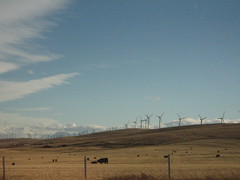
One means of reducing carbon emissions is the development of new technologies such as renewable energy such as wind power. Most forms of renewable energy generate no appreciable amounts of greenhouse gases except for biofuels derived from biomass.
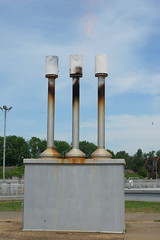
#> Burn Methane:
Burning Waste Methane. Methane is a much more powerful greenhouse gas than carbon dioxide. Burning one molecule of methane generates one molecule of carbon dioxide. Accordingly, burning methane which would otherwise be released into the atmosphere (such as at landfills, coal mines, waste treatment plants, etc.) provides a net greenhouse gas emissions benefit.
#> Use Smart Cooler, Heater & Air Conditioner 
About half the energy we use in our homes goes to heating and cooling. Changing air filters annually, having your system checked annually and useing a programmable thermostat are all easy things you can do. Just by using a programmable thermostat, you can save about 1,800 pounds of carbon dioxide a year and about $100 a year in energy costs. If you want to go the extra mile, see “Bonus Tips” below for how to purchase green power.
 #>Tune up and maintain vehicles properly
#>Tune up and maintain vehicles properly
Unscientific maintain of vehicle leads to environment pollution. Vehicles, regardless of category are increasing day by day all over the world. The smoke released by these vehicles damage ozone layer. But it is impossible to stop the arrival of new vehicles. What can be done to the maximum is, to maintain the vehicles properly. Adopting scientific method to maintain your loved cars and bikes will play predominant role in controlling global warming.
#>Clean the air in your house.
Cleaning the air inside the house is most important thing. By doing so you will automatically contribute for global warm control. There are many things you can do to clean your house. Use proper vacuum cleaner for the purpose. Clean regularly and continuously. Put dust avoiding curtains and use houseplants. Do not keep the dustbin unchecked. lso don’t mess the surroundings of your house. Even take maximum care while dispatching waste materials. Try to grow as much as saplings inside your compound.
 #> Reduce electricity usage to the maximum
#> Reduce electricity usage to the maximum
Switch off unwanted electric equipments immediately. Or do not use them if not necessary. Often we find shining tube, unning fan, running TV…etc. One may be sound enough to pay the electric bill in the end of the month, but what about the energy that has been wasted? Replace the old ones with energy efficient lighting. Also, improve the efficiency of ome appliances. If not possible, go for an energy saving appliances.
#>Prefer recycling  Preferring reusable products instead of disposables will help in reducing the waste. When you buy a product, make sure that the packing is quite reasonable one. In other words, packing should not exceed the size of the product. Always try to recycle household waste. By recycling the household waste, one can save 2,400 pounds of carbon dioxide annually.Here both the entrepreneurs and public should join hands together for a cause. Always try to educate others on preferring recycling products.
Preferring reusable products instead of disposables will help in reducing the waste. When you buy a product, make sure that the packing is quite reasonable one. In other words, packing should not exceed the size of the product. Always try to recycle household waste. By recycling the household waste, one can save 2,400 pounds of carbon dioxide annually.Here both the entrepreneurs and public should join hands together for a cause. Always try to educate others on preferring recycling products.
Sunday, June 7, 2009
Stop global warming, save Earth
How to save our mother earth from global warming
1.Automobiles stay ahead of everything in the emission of carbon, so as for as possible try to avoid using your automobile for short distances.
2.Instead of everybody using their own vehicle if some of you are working in the same area and living in the same area you can share one vehicle.
3.Now everything can be done through net instead of going to the banks, stations, markets and etc you can do the same by sitting at your home in front of your system.
4. You can reduce the usage of your refrigerator, If you think that how much my refrigerator is going stand as a cause, don't see as one refrigerator of your home count the no of refrigerators around the world in each home and shops, Hotels etc,.
5.Start using the recycle base articles, change from plastic to paper.
6.We can change ourselves to use cotton cloths than silk rayon cloths.
7.As much as possible use cotton bags or paper bags than plastic bags.
8.Instead of searching for a solution how to destroy the used batteries, start using rechargeable batteries.
9.The waste water that is been let out in the process of leather tanning process spoils the soil and its fertility either we should reuse the water through water treatment plants or we should avoid using leather articles.
10.Let us avoid use and throw articles in our daily uses because almost 90 percent of these kind of articles are being made of plastics.
11.Let us grow at least a tree in every house.
12.To stop the forests getting destroyed, the heart of mother nature you can simply avoid using wooden articles.
13. Attend all your vehicles schedule check ups without fail, to Keep your vehicles in good condition and intact .
14.Give special attention to the carburetor, and silencer of your vehicle.
15.Scientists say even the chemicals used for domestic cleaning also destroys the atmosphere since use soda, lemon and vinegar instead of the chemicals.
We can teach our children how to love nature and how important it is to safeguard the world.Instead of keeping them a big asset it is very important for us to keep a wonderful natural and healthy world for them to enjoy their life. It is-true improvements is unavoidable but we can avoid destroying the earth for it is not our permanent property for us to enjoy on our own as we wish. we are only sharing and it should handed over to the following generation with the same way how we got it from our predecessor.
I also welcome more ideas that we can share to join hands in this mission.
When the whole world is searching for new ways and means to fight global warming, an Indian agricultural scientist, Dr. N. Bharathi, said bamboo was a practical atmospheric carbon absorbing plant. He added, " It is the fastest and least expensive way to solve the problems of carbon-dioxide emission and water pollution."
Bamboo absorbs carbon-dioxide and releases oxygen into the atmosphere three to four times higher than many other trees. Bamboo also enriches the soil naturally and prevents soil erosion and effectively cleans the water pollution of of the septic tank discharge and factory effluent by its natural affinity for nitrogen, phosphorus and heavy metals. One mature Bheema Bamboo (Bambusa Balocava) would absorb above 500 kgs of carbon-dioxide.
A few more:
With the number of natural disasters growing high everyday, it is almost as if the earth is crying out loud for our help. Statistics have put an eight year timer on the time - bomb that is now our planet.
Become a part of your school, college, office, or your residential area's environment clubs. Participate in activities to clean up the city you live in.
Garbage lying around begins to ro6t and plays a huge role in polluting the soil, air and water the very basic essentials that we require to live. Picking up garbage and throwing it in dustbins is a great way to start living clean. Try to composite kitchen waste and other organic wastes. This composite is also a great fertilizer and it helps reduce the amount of trash that you send to your local garbage dump.
Follow this three important three green rules:
1. Reduce 2. Reuse and 3. Recycle
Follow this three rules strictly so that you can reduce the amount of waste by knowing which items are recyclable. For example, cardboard, paper and glass are all recyclable materials, and once they have been recycled, they can be reused.
Use cloth bags or jute bags to carry groceries or other items. Stop immediately using paper or plastic bags or materials that cannot be recycled. If you are made to use paper or plastic bags, ensure that you get them recycled so that they can be reused.
When on market, look for the three arrows that make a circle denoting recyclable material. That way you know the products which you are buying can be recycled and will help protect the environment.
Climate change is mainly brought about by the release of toxic green house gases like carbon dioxide into the air. The best way to reduce this greenhouse gases is to grow more trees which use these gases for their food making process. Plant fresh saplings in your park, office, school, college, or your garden and if possible make a community planting by joining hands with your friends, family and your neighbours. Help the earth, breathe.
Vehicular pollution is the most major cause of air pollution in big cities. While no one is saying stop driving cars, but you can be smart about it.
Walk or use public transport whenever you are going to a nearby place or to office. Carpooling, or even riding a bicycle is a great way to cut down both fuel costs and usage and pollution and also help you keep fit.
If you aren't using electrical appliances switch them off. Leaving them on only contributes to the loss of more and more precious fuel resources.
Don't use more water than you need, and now that the rainy season on the corner adopt rain water harvesting to help raise ground water levels.
Can we justify to destroy such a beauty - think

Saturday, June 6, 2009
Polythene: A bagful of poison
Trillions of polythene bags are used world over every year.They persist on this earth to haunt us and our generations for centuries.
pic credits: green hopes.
Polythene: A bagful of poison
Trillions of polythene bags are used world over every year.They persist on this earth to haunt us and our generations for centuries.
Plastic bags consumed this year around the world:
250,337,862,715
Polythene chokes the drains, the water bodies, pollutes the land and poisons us slowly but surely. Wake up! There may still be time!
pic credits: green hopes.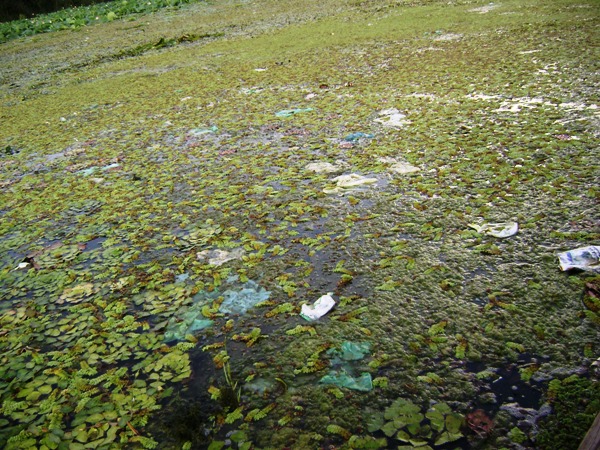
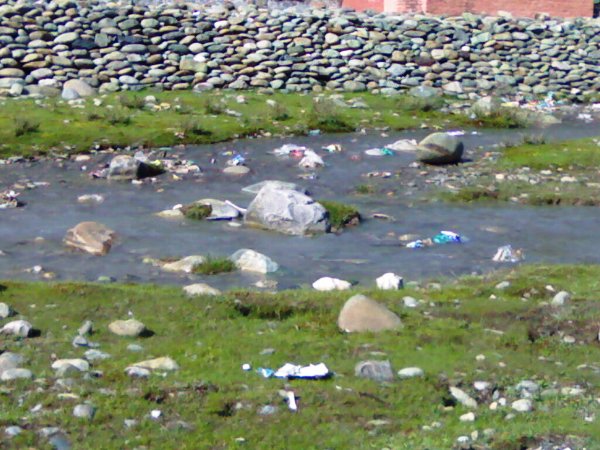

Pic credits: green hopes.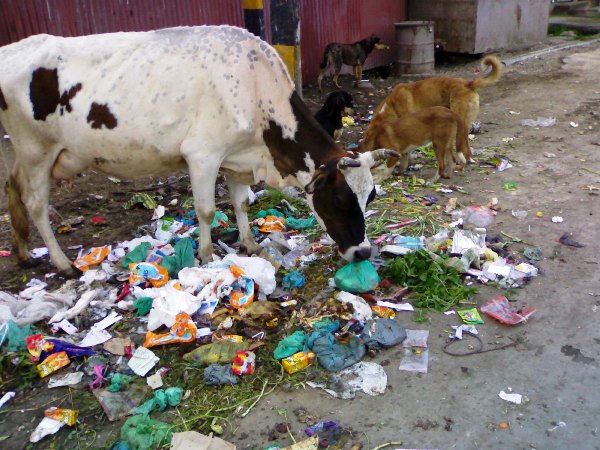
These innocents are the major sufferers of this menace.
Pic credits: green hopes.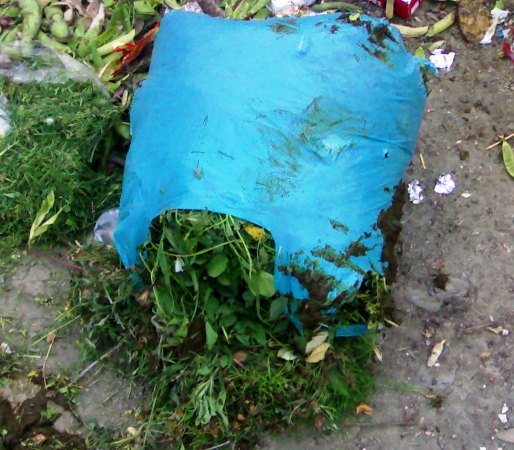
Poly insult.Even mowed grass cannot escape the polythene menace.
Pic Credits: green hopes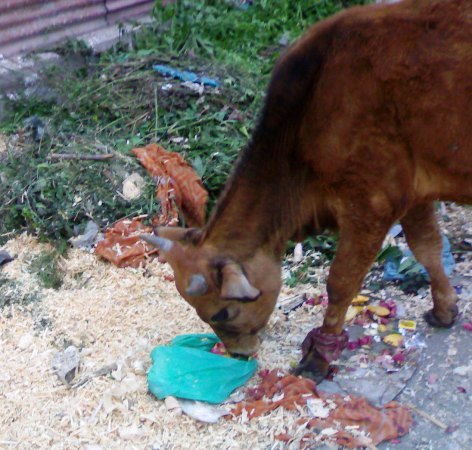
This is a frequent sight in kashmir.Polythene has been recovered from the rumen of countless cattle and is a major threat to animals also
Pic Credits: green hopes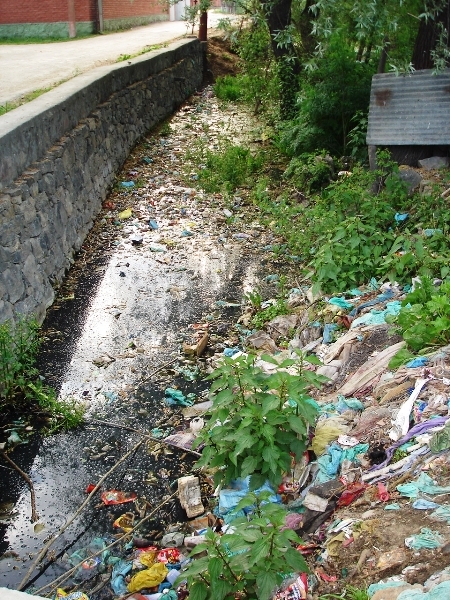
A stream once flowing into Jhelum River is now a cesspool.Polythene and sewage did the dirty job.
Pic Credits: green hopes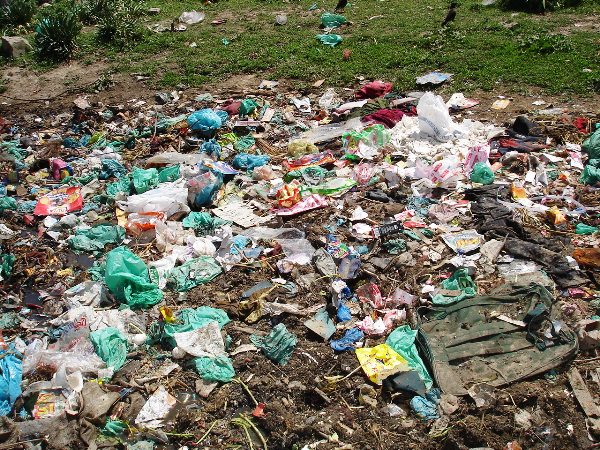
Polythene pollution is an epidemic now.
Pic Credits: green hopes

A choked drain. Polythene the culprit again.Pic Credits: green hopes
Too loud to be a whisper. Polythene in the middle of Nigeen Lake
Pic Credits: green hopes
Friday, June 5, 2009
DSC 2009 key
Thursday, June 4, 2009
Think well...Think fast...
What's the formula for thinking well and thinking fast?
![]() Experiential intervention that encourages risk-free experimentation.
Experiential intervention that encourages risk-free experimentation.
![]() Authentic environment that provides hands-on, total immersion opportunities
Authentic environment that provides hands-on, total immersion opportunities
![]() Collective brainpower that brings together a mix of "thinkers" with diverse backgrounds and perspectives
Collective brainpower that brings together a mix of "thinkers" with diverse backgrounds and perspectives
![]() Proven processes, techniques and tools that enhance both creative and analytical thinking
Proven processes, techniques and tools that enhance both creative and analytical thinking
![]() Well-crafted action plans that transform ideas into useable solutions
Well-crafted action plans that transform ideas into useable solutions
Generating powerful business solutions isn't a "lucky break." In fact, an organization's survival depends on having teams that can consistently and deliberately think about problems and issues, then develop new and effective ways to address them. Success requires deep, exploratory thinking that leads to solutions with structural and lasting impact.
Organizations come to us because they want to meet their complex challenges within the tight timeframes demanded in today's ever-changing marketplace. We help them by designing a thinking environment that allows them to think well and think fast.
Thunderbolt Thinking Experiences get results FAST, helping your team or organization generate a wealth of groundbreaking solutions in an intensive environment that enhances both creative and analytical thinking.
Superior facilitation and effective thinking techniques keep teams energized, creative and productive.Our facilitation processes have helped organizations quickly zero in on the most effective solutions and then develop solid plans to put them into action.
A fast-paced format moves you quickly from idea generation to solutions that meet customer criteria.Our clients are constantly amazed at the amount of work they accomplish in a Thunderbolt Thinking session. The outcomes are innovative, practical, and backed up with solid action steps that ensure implementation. Breakthrough results in a focused, intensive session save you time and money.
Pre-thinking and analysis balance internal biases and ensure results that address product/brand issues, and thorough written summaries capture all information in useable, action focused formats.
White Hat – What are the six thinking hats?
The Six Thinking Hats is a method devised by Edward De Bono and meant to improve the results of thinking and discussion. It may be used either by oneself or in a group. De Bono claims that by separating six different types of thinking we can make our thinking clearer and more thorough. We should "wear" each hat in turn, and analyze the issue at hand from six different aspects separately. In a group setting, the entire group is encouraged to use just one hat at a time, thus contributing to an organized and comprehensive discussion, rather than a confused and mixed-up argument. Each hat is marked with a different color and represents the following type of thinking:
- White Hat represents facts, information, and statistical data, as well as identifying missing information and from which sources it may be collected.
- Red Hat symbolizes emotions and feelings. While wearing this hat, people are "allowed" to express their feelings about the subject or to share their general mood, which might be affecting their participation or lack of it. This hat does not require logical reasoning or justification, as feelings are almost always subjective rather then rational.
- Yellow Hat signifies positive rationality, and is used to look at the positive aspects of a situation or idea, on the potential benefits of the suggested course of action, and on the parties who are expected to profit from it. It is emphasized that support for the idea should be logically justified and not simply stated without explanation.
- Black Hat is in a way the opposite of the Yellow Hat. It is used for discussing the negative repercussions of the plan, the potential dangers, and any criticism on the logic of arguments made in its support. As in the case of the positive hat, logical justification is expected when presenting the reservations rather than opposition for the mere sake of opposition.
- Green Hat stands for creativity and unconventional thinking. When wearing this hat, people are encouraged to think creatively (although in this case De Bono does not specify how). Brainstorming, creative thinking tools, lateral thinking and other such methods are to be used in order to search for unexpected developments of the idea or the discussion.
- Blue Hat - this hat is used for directing the discussion, for switching hats when necessary, for summarizing the major points of the discussion, as well as for making decisions.
Saturday, May 16, 2009
AP Election Results 2009 - Live Blogging 05:40
 | ||||||||||||||||||||||||||||||||||||||||||||||||||||||||||||||||||||||
| ||||||||||||||||||||||||||||||||||||||||||||||||||||||||||||||||||||||
 |


